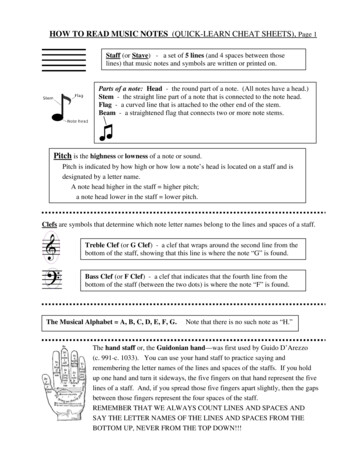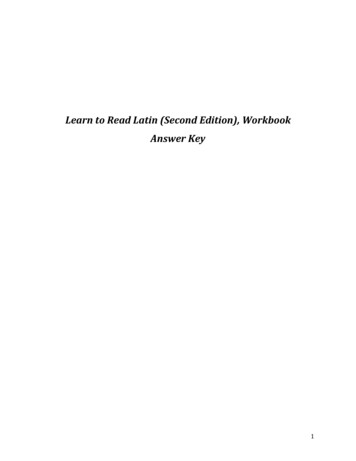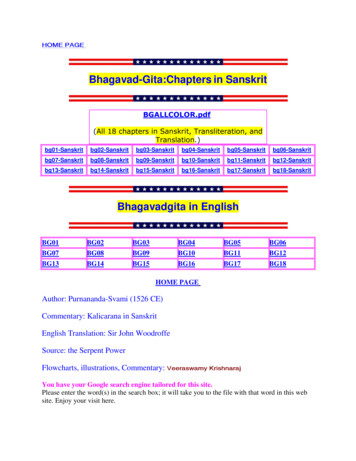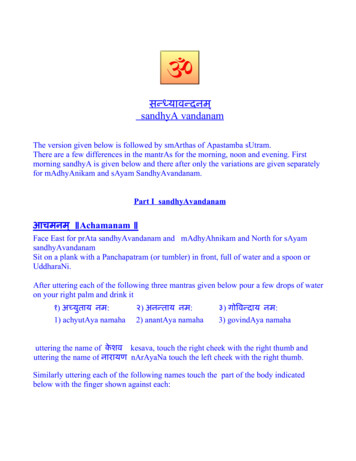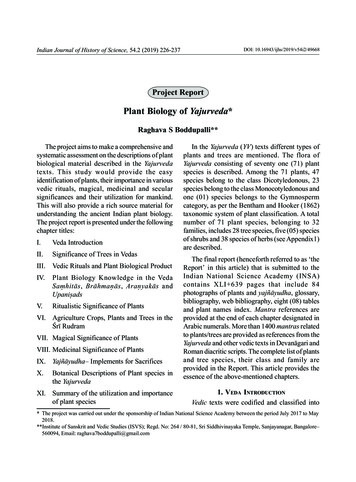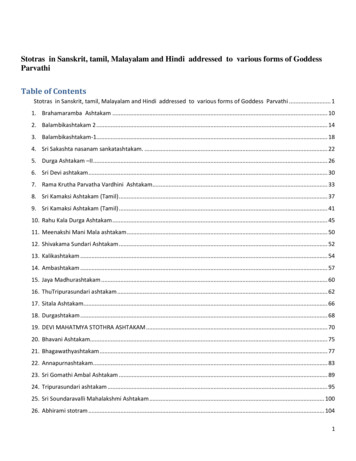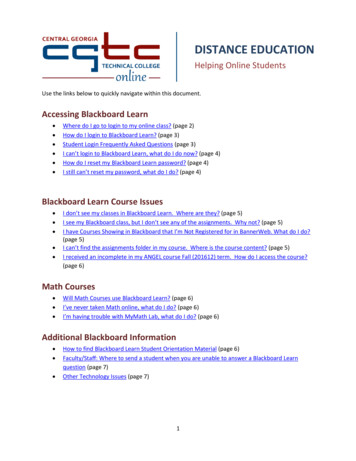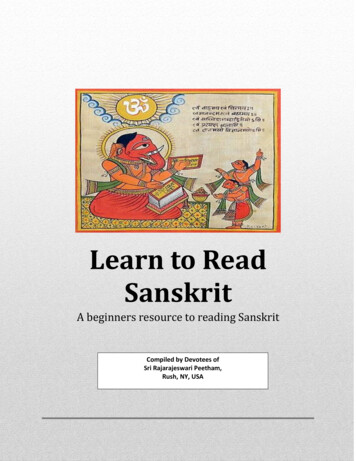
Transcription
Learn to ReadSanskritA beginners resource to reading SanskritCompiled by Devotees ofSri Rajarajeswari Peetham,Rush, NY, USA
Table of Contents0.0An offering at his lotus feet . 31.0Introduction . 42.0Sanskrit Writing System . 532.1Sanskrit Aksharas (Alphabets) . 52.2Sanskrit Alphabet Chart . 62.3Writing Sanskrit Alphabets . 7Reading Sanskrit . 103.1Vowels . 103.1.1The short vowels. 103.1.2Long Vowels . 113.1.3Support Vowels. 123.2Consonant . 133.2.1Generic form of a consonant . 133.2.2Consonant Group-1: Gutturals . 153.2.3Consonant Group-2: Palatals . 153.2.4Consonant Group-3: Cerebrals . 163.2.5Consonant Group-4: Dentals . 163.2.6Consonant Group-5: Labials . 173.2.7Consonant Group-6: Semivowels, Sibilants etc. . 173.3Consonant Vowel combinations – Swarayukta Vyanjana . 183.4Conjuncts (Samyuktakshar) . 223.5Writing methods for Conjuncts . 223.6Samyuktakshar and vowel combinations. 253.7Conjuncts with "ra" . 253.8List of Conjuncts . 273.9Aksharas that look very similar . 373.10 Vedic Symbols . 383.11 Rarely used Aksharas . 393.12 Numerals (s'!Oya - sa khy¡: ) . 403.13 Practice – Akshara Recognition . 413.14 Practice - Aksharas . 441
3.15 Practice - Words . 453.15.1Short Words . 453.15.2Long Words . 463.16 Common words in Vedas . 474Simple words and phrases . 494.1Gods names . 494.2Grahas . 504.3Directions . 504.4Gaurdians of directions (दिक्पाल-dikpāla ) . 514.5Fruits ( Pla n - phal¡ni). 514.6p Ýpa N - puºp¡²i (Flowers) . 524.7Body parts ( Sr rÞy Bag: ¹ar rasya bh¡ga: ) . 524.8vasra – Days . 544.10 Simple phrases . 555Slokas - Small . 566Shanti – Mantras ( zaiNtmÙa -7Slokas, Suktams and Sahasranamam . 622. 57
0.0 An offering at his lotus feetSri Gurubhyo Namah!“The root of meditation is the guru’s form. The root of worship are the guru’s feet. Theroot of mantra are the guru’s words. The root of liberation is the guru’s grace.”- Sri Guru GitaWe offer this work at his Lotus Feet, our guru Sri Chitanyananda Natha Saraswati of SriRajarajeswari Peetham, Rush, NY, USA.This guide, “Learn to Read Sanskrit”, is mostly a compilation of resources from variousSanskrit Literature and works from the world-wide-web. Although we used severalresources, major credit goes to the “Learn Sanskrit through self-study” guide at thefollowing web ollowing are other resources that we extensively used in this ot.com(Ager, Simon. "Omniglot - writing systems and languages of theworld". Omniglot was first published on the web in November 1998)We are not Sanskrit scholars; however we have some exposure to Sanskrit. Inspired by ourGuru, we have a strong desire to do something for younger generation. This life time is notenough to read all the Vedic scriptures, but we believe that learning to read Vedas is in itsoriginal form can definitely be achieved. This work attempts to aid in reading Sanskrit andvedas. With Guru’s grace, it is our sincere hope that this work will achieve its goal.Devotees of Sri Rajarajeswari Peetham,Rush, NY, USASri Gurubhyo Namah!3
1.0 IntroductionSanskrit is the language of Vedas. A meaningful study of Vedas will not be complete withoutthe knowledge its script - Devanagari. Although Vedas can be learnt using English diacritics,it will be almost impossible to master the correct pronunciation. It is our firm belief thatSanskrit can be learnt by anyone. In order to enjoy the nectar of Vedas, it is essential thatwe learn to read Sanskrit.There are many resources available on the web that will help you to learn read, write andspeak in Sanskrit. The main aim of this guide is to teach you reading Sanskrit. Not writing orspeaking. However, while learning to read Sanskrit you will also learn to write in Devanagariscript - at least we hope. You may realize that it is easy to remember the letters when youpractice writing. We encourage that you print the alphabets from this guide and practicewriting.This guide starts with an introduction to Devanagari Script and writing in Sankrit. It thenintroduces the Swaras, the “sounds” of Sanskrit and reading methodology. In later sectionsyou will learn how to pronounce Sanskrit sounds. It then gradually takes you to readingsimple words to complex words. In the final sections you will learn to read simple slokas,complex slokas and Suktams. We have already published reading modules for Suktams andLalitha Sahasra Nama and they are available on our web site for download. We hope youwill use all the resources and learn to read Vedic scriptures.We pray that the Guru’s Grace and Devi’s blessings be always with you. Have a happyreading!4
2.0 Sanskrit Writing SystemThe writing system used for Sanskrit is known as Devanagari. Indian languages arephonetic in nature and the written shapes represent unique sounds.In Sanskrit and other Indian languages, unlike in English, there is no specific name givento the letters. The sound the letter stands for is actually the name for the letter. In aphonetic language, like Indian languages, you need to read out the words by utteringthe sound, the Swara associated with each Akshara (the letter).Note on Reading Devanagari using Diacritics: There are many methods being adopted toread Sanskrit. One of such method is through special notation on Roman letters calleddiacritics. The diacritics, which consist of marks written above or below a letter of thealphabet, indicate variations in the sound associated with the letter. Dictionaries alsofollow this method to help the reader identify the manner in which the word should bepronounced. Following example illustrate diacritics notation scheme:kmlaKl gNp tkamal¡ khalu ga²apatiAnGact rÄñ anagh¡catura ga Notable Features in Sanskrit Alphabets: Consonant letters carry an inherent vowel which can be altered or muted bymeans of diacritics or matra.Vowels can be written as independent letters, or by using a variety of diacriticalmarks which are written above, below, before or after the consonant theybelong to. This feature is common to most of the alphabets of South and SouthEast Asia.When consonants occur together in clusters, special conjunct letters are used.The order of the letters is based on articulatory phonetics.2.1 Sanskrit Aksharas (Alphabets)Sanskrit alphabet is called Varnamala, literally means garland of letters. Sanskritalphabets are classified into four groups. Here is the list. We will cover each of these indetail in later sections:Þvra: ( svar¡: ) – VowelsÛy na n ( vya jan¡ni ) – ConsonantsÞvry ³-Ûy na n (svarayukta-vya jan¡ni) – Consonants with vowelss y ³-Ûy na n (sa yukta-vya jan¡ni) – Conjunct consonants5
2.2 Sanskrit Alphabet Charts Þk]tvNImala - sanskritvarnamalaShort VowelsLong VowelsSupport VowelsAiu§ûaiu µAaiIU eeEAaEA ¡ ai§aukKgGHkakha gagha acCJMcacha jajha azZFN·a·ha a ha ²atTDtatha dadha napPBpapha baA A:a a Consonant Group-1: GutturalsConsonant Group-2: PalatalsConsonant Group-3: CerebralsConsonant Group-4: DentalsConsonant Group-5: Labialsjfdbnmbha maGroup 6: consists of three lava¹aºasaha
2.3 Writing Sanskrit AlphabetsAs we mentioned in the beginning of this book it is not necessary to learn to write Sanskrit inorder to learn reading. However, if you learn to write, it will be easier to read. You can usefollowing as a guide to practice writing Sanskrit.Sanskrit Writing – Vowels7
Sanskrit Writing – Consonants, Semivowels and Sibilants8
9
3Reading SanskritAs we discussed in the beginning of this book, main focus here is reading Sanskrit. In thefollowing sections we will provide Sanskrit alphabets and reading method. Along with Sanskritalphabets we also have provided the Roman letters with diacritic notations to aid in reading. Inthe beginning use the Roman diacritics as a guide to read Sanskrit. Eventually you should bereading Sanskrit letters without the help of Roman diacritics.3.1VowelsVowels form an independent group from the consonants. The vowels are called"swaras" in Sanskrit. “Swara”, means sound and each vowels represent a certain“sound”. There are fifteen vowels which comprise of five short ones, eight long onesand two support vowels. Among these fifteen, only thirteen are in normal use thesedays.There are two types of vowels: Short Vowels – Long Vowels3.1.1 The short vowelsThe short ones are referred to as "hraswa" swaras. .Aiu§ûaiu µA is pronounced as in cup, bus etc.iis pronounced as in inform, init etc.uis pronounced as in look, book etc.§ has no direct equivalent and is pronouncedsomewhere in between ri and ru, like crystal.û is also like § and is pronounced somewherein between li and lu similar to glycerene.10
3.1.2 Long VowelsThere are eight long vowels.These are pronounced for a duration typically twice that of the short ones.The long vowels also include two vowels that are treated as diphthongs.However as far as Sanskrit is concerned they are not strictly diphthongs.AaiIU eeEAaEA ¡ ai§auThe first four are the long forms of thecorresponding short vowels.e and AaE are long vowels which do not haveshort forms in Sanskrit.eE and A are often likened to diphthongs thoughthey are not strictly combinations of two vowels.11Aais pronounced as in far, bar, fall etc.iIis pronounced as in easy, eagle etc.Uis pronounced as in rooster, fool etc. is the l
will use all the resources and learn to read Vedic scriptures. We pray that the Guru’s Grace and Devi’s blessings be always with you. Have a happy reading! 5 2.0 Sanskrit Writing System The writing system used for Sanskrit is known as Devanagari. Indian languages are phonetic in nature and the written shapes represent unique sounds. In Sanskrit and other Indian languages, unlike in English .File Size: 2MBPage Count: 63

